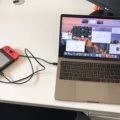Are you havig trouble connecting your MacBook Pro to the internet using an Ethernet connection? Don’t worry – we’ll walk you through the steps to get it up and running in no time.
First, make sure you have all the necessary equipment: an Ethernet cable, a compatible Ethernet adapter if your MacBook Pro does not have an Ethernet port, and your modem. Once everything is connected, you will need to configure the settings on your MacBook Pro.
Open System Preferences and select Network. Under “Network”, select “Ethernet” from the list of options. Select “Using DHCP” from the drop-down menu under “Configure IPv4” and ensure that “Ethernet Status” shows either “Connected” or “Inactive” (If it doesn’t show either of these statuses, check that all cables are properly connected).
Next, open up your web browser and try loading a page. If you can access the internet, then congratulations! Your Ethernet connection is now working correctly on your MacBook Pro.
If this process did not work for you, then there may be smething wrong with either your hardware or network configuration. If this is the case, we recommend consulting with a professional to troubleshoot any issues you may be facing.
We hope this guide was helpful in geting your internet connection up and running on your MacBook Pro!
Making a MacBook Pro Recognize an Ethernet Cable
To get your MacBook Pro to recognize your Ethernet cable, you’ll need to make sure that both the Ethernet port on your computer and the device are connected securely. First, remove the cable, then reconnect it firmly to ensure a good connection.
Next, open System Preferences on your Mac and click on Network. Check that your network settings are correct—if you’re not sure whih settings to use, contact your Internet Service Provider (ISP). After verifying that the settings are correct, click “Apply” or “OK” and then check if the Ethernet cable is now recognized by your MacBook Pro.
If it’s still not working, try restarting both your Mac and the device you’re connecting to. If this doesn’t help, try using a diffeent Ethernet cable or port. If none of these solutions work, please contact Apple Support for further assistance.
Configuring Ethernet Manually
1 Begin by connecting a LAN cable to the PC’s wired LAN port.
2 Next, open the Network and Sharing Center. To do this, click the Start button on the taskbar, then click Settings, followed by Network and Internet. In Status, click Network and Sharing Center.
3 Choose Change adapter settings at the upper left to display all of your network connections.
4 Right-click Ethernet and then select Properties. A new window will appear with several tabs at the top.
5 Click on Internet Protocol Version 4 (TCP/IPv4) to highlight it and then click Properties to open its configuration window.
6 When in the TCP/IPv4 Properties window you can select either Obtain an IP address automatically or Use the following IP address wich you must configure manually according to your individual network requirements.
7 If you choose Use the following IP address, you must enter in your IP address as provided by your network administrator along with a Subnet mask and Default gateway configured according to your network’s settings. Additionally, if your network requires it for DNS resolution, you can enter in Preferred DNS server and Alternate DNS server information into this window as well before clicking OK to save your changes.
8 Finally, click Close twice on both windows to save all of your changes and complete manual Ethernet configuration.
Switching Automatically from Wi-Fi to Ethernet on Mac
Yes, Mac will automatically switch from Wi-Fi to Ethernet when it detects an Ethernet connection. When both connections are available, the Ethernet connection will be preferred bcause it typically provides a faster and more reliable connection than Wi-Fi. However, if the Wi-Fi connection is stronger or faster than the Ethernet connection, then Mac may choose to use the Wi-Fi connection instead. You can also manually configure your Mac to prefer one connection over the other.
Benefits of Having Two Ethernet Ports on a Mac Pro
The Mac Pro features two Ethernet ports so that users can take advantage of high-speed networking. The first port is used to connect to the internet and the second port can be used for a high-speed (1 Gbps) connection between computers or file servers. This allows users to transfer files quickly and reliably, without sacrificing bandwidth for internet usage. Additionally, this gives users more flexibility when connecting additional devices to their network, as they can choose to use either port as needed.
Troubleshooting Ethernet Cable Detection Issues
There are several possible reasons why your Ethernet cable is not beng detected. First, check that the Ethernet cable is securely plugged into the Ethernet port on both your router and Windows 10 PC. Also make sure you are using the correct Ethernet port on your router (not the Internet port). Additionally, if you are using a switch or hub, make sure it is powered on and connected to both devices. Finally, open Device Manager on your computer and check if the network adapter is enabled. If not, right-click it and select Enable. If this doesn’t work, try re-installing the network driver from the manufacturer’s website or Windows Update.

Source: appletoolbox.com
Troubleshooting Ethernet Connection Issues on Mac
There could be a few different reasons why your Ethernet connection is not working on your Mac. It could be an issue with the router, a problem with the Ethernet cable, or an issue with your Mac’s networking settings. To determine the cause of the problem, start by making sure that all of your hardware is connected correctly and that the router is powered on and functioning properly. If everything looks good there, then you should check to make sure that you have the apropriate network settings enabled on your Mac. If this doesn’t solve the issue, then it may be necessary to reset both your router and Mac to their default settings and try again.
Setting Up an Ethernet IP Address on a Mac
Setting up an Ethernet IP address on a Mac is a simple process. First, open the System Preferences app and click on Network. Next, select the network connection that is connected to the USRP radio from the left pane. Then, click on Advanced and select the TCP/IP tab. Set Configure IPv4 to Manually and enter an IP address (such as 192.168.0.1) in the IP Address field and a subnet mask (such as 255.255.255.0) in the Subnet Mask field. Once you have entered your desired settings, click OK and your host computer configuration will be complete!
Connecting to Ethernet Manually on Mac
To manually connect to Ethernet on Mac, you’ll need an Ethernet cable and an active internet connection.
First, plug one end of the Ethernet cable into your router or the othr computer you wish to directly connect to your Mac. Then, plug the other end of the cable into the Ethernet port on your Mac.
Once that’s done, you can open a browser to test the connection. If everything is properly connected, you should be able to access the internet. If not, double-check that all connections are secure and that there’s an active internet connection on the device you’re trying to connect your Mac to.
Switching from WIFI to Ethernet on a Mac
To make your Mac use Ethernet instead of WIFI, first open System Preferences and select Network. Then select an Ethernet service on the right side of the window. You may need to scroll down to see the service. Click Details to change the settings for the network service, then choose Ethernet from the drop-down menu. Now, you can configure your Ethernet connection and connect your Mac to a wired network.
Setting Up Ethernet Instead of WIFI
Setting up Ethernet intead of WIFI is a straightforward process. First, you need to connect an Ethernet cable from the router or modem to the computer. The cable should be plugged into the Ethernet port on your device, which is usually located on the back of the computer or laptop. Once connected, you’ll need to configure the network settings on your device. In most cases, this will involve opening up your Network Settings and selecting “Ethernet” as your preferred connection type. Once this is done, you should be able to access the internet through an Ethernet connection instead of WIFI.
Choosing Between Ethernet and Wifi on Mac
When you have both Wifi and Ethernet connections available, Mac OS will prioritize Wifi over Ethernet. This is because Wifi typically provides a faster connection than Ethernet due to the higher bandwidth it offers. Additionally, Mac OS considers the distance of the device from the router when selecting a connection type: if the device is closer to a Wifi router than an Ethernet router, it will select that connection for btter performance. The Service Order setting in System Preferences does not override this behavior.
Are Wi-Fi and Ethernet MAC Addresses the Same?
No, the Wi-Fi and Ethernet MAC addresses are not the same. A MAC address (also known as a Media Access Control address) is a unique identifier assigned to network adapters (such as Ethernet cards and Wi-Fi cards) used in a computer or oher device. Each network adapter has its own unique MAC address that is used to identify it on the network. Therefore, your Ethernet card will have one MAC address, while your Wi-Fi card will have another.
Do Different Ethernet Ports Have Unique MAC Addresses?
Yes, different Ethernet ports will have different MAC addresses. A MAC (Media Access Control) address is a unique identifier assigned to each network interface on a device. Every Ethernet port will have its own hardware-defined address which is used to communicate with other network devices. The format of a MAC address is typically either six pairs of hexadecimal numbers or twelve hexadecimal numbers separated by colons, and it can usually be found in the system configuration of your device.
Does the MacBook Pro Have an Ethernet Connection?
Yes, some MacBook Pro models do have an Ethernet connection. Depending on the model and year, you may need to use a compatible adapter, such as the Belkin USB-C to Gigabit Ethernet Adapter or the Apple Thunderbolt to Gigabit Ethernet Adapter. Additionally, you will need to connect an Ethernet cable between your router or modem and the Ethernet port of your Mac.
Conclusion
In conclusion, configuring Ethernet on a MacBook Pro is relatively straightforward. All you need to do is connect an Ethernet cable to the Ethernet port on the MacBook Pro, and then go into System Preferences to check your network settings. Make sure that the settings are correct and then you should be able to get online via your wired connection. Additionally, having two ports on your MacBook Pro allows for a high-speed (1 Gbps) link between computers and file servers while still having access to the internet through the other port at regular speeds.







